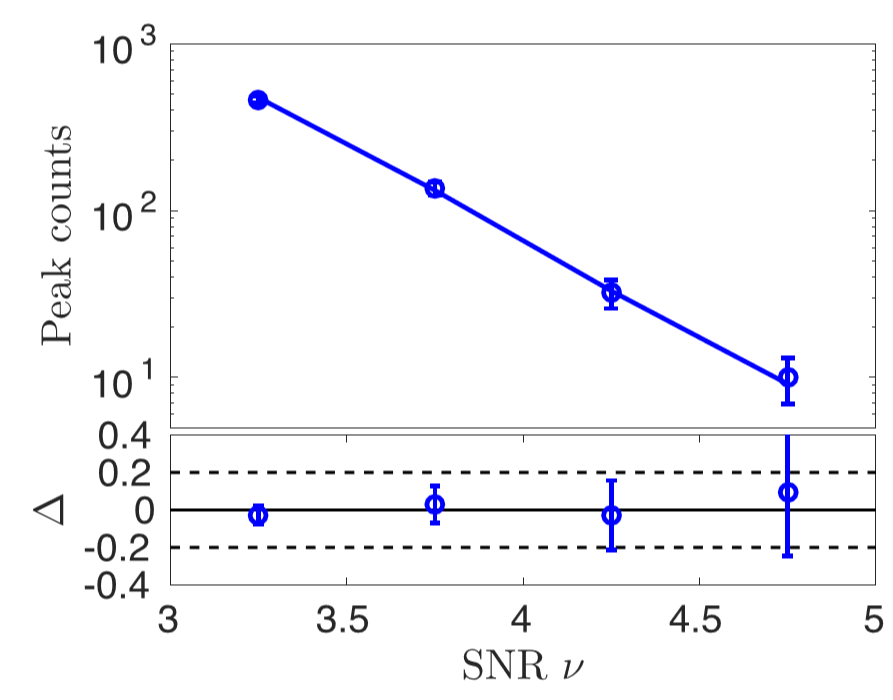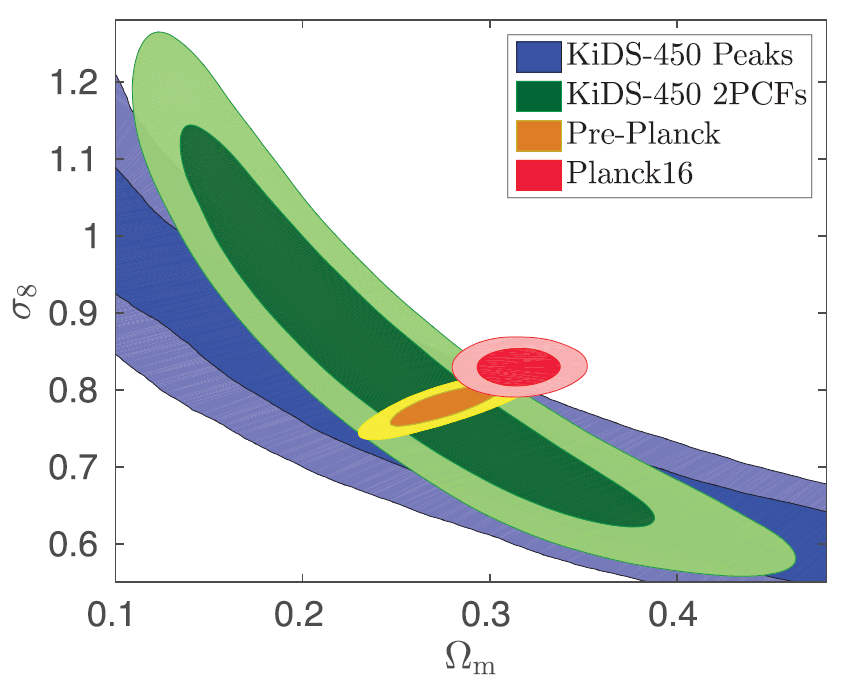宇宙学团组基于KiDS开展弱引力透镜宇宙学研究取得新成果
New cosmological constraints from WL peak statistics with KiDS-450
近日,与欧洲KiDS(The Kilo-Degree Survey) 巡天项目组合作,云南大学中国西南天文研究所范祖辉教授带领的宇宙学团组基于KiDS ~450 deg2(记为KiDS-450)天区的弱引力透镜观测数据开展了详细的弱引力透镜峰值统计宇宙学分析,对宇宙学参数给出了新的限制。
宇宙大尺度结构产生的引力效应会改变时空性质,造成光的传播路径发生偏折,这使得所观测到的远处星系的形状和亮度发生微小改变,这个效应称为弱引力透镜效应,是公认的最重要的宇宙学探针之一。正在进行的KiDS巡天专为弱引力透镜分析所设计,是国际主要第三代透镜巡天项目之一,计划在(u, g, r, i)四个波段对~1500 deg2的天区进行观测。
在本工作中,利用KiDS-450观测数据,我们构建了以透镜效率因子为权重的二维投影物质分布场,即透镜汇聚场,并进行了峰值统计。利用本团组提出和开发的峰值统计理论模型及分析平台,我们进行了宇宙学限制,深入研究了包括重子物理效应以及星系团成员星系污染等效应在内的各种系统误差所带来的影响。图1左图展示了我们得到的KiDS-450峰值数目分布,右图展示了本工作中KiDS-450弱引力透镜峰值统计(蓝色)和之前的KiDS-450透镜剪切两点相关分析(绿色)、Planck卫星之前的微波背景辐射分析(黄色)以及Planck卫星的微波背景辐射分析(红色)所得到的对宇宙学参数的限制结果的比较,这里σ8,Ωm分别为反应物质密度扰动大小和今天宇宙中物质含量的物理量。


图1. 左图:KiDS-450峰值分布。右图:KiDS-450弱引力透镜峰值统计(蓝色)、透镜剪切两点相关分析(绿色)、Planck卫星之前的微波背景辐射分析(黄色)以及Planck卫星的微波背景辐射分析(红色)所得到的对宇宙学参数的限制结果的比较。
从右图可以看到,我们的结果与之前KiDS团队开展的两点相关分析结果高度符合。峰值分析所携带物理信息侧重于大质量非线性物质结构,突出了物质分布场的非高斯统计性质,与两点相关分析互补。二者所得结果的一致性进一步提高了KiDS-450宇宙学限制的置信度。我们进一步看到,KiDS-450的限制与Planck微波背景辐射所得结果存在差别,限制量S8=σ8(Ωm)0.5相差约2σ。因微波背景辐射反映了早期宇宙演化行为,而弱引力透镜分析敏感于后期结构形成过程,两种观测给出的宇宙学结果的不一致引起了人们极大的兴趣,而深入理解这一差别已成为当前宇宙学领域的重要前沿。
该研究工作已被天文学主要国际学术期刊《皇家天文学月刊》(Monthly Notices of the Royal Astronomical Society)接受,将于近期发表(预印本文库链接https://arxiv.org/abs/1709.07651)。本研究团队中的云南大学中国西南天文研究所刘项琨博士是该工作的主要完成人,是文章的共同通讯作者,北京大学研究生潘楚中具有核心贡献。

In collaboration with the large European KiDS (The Kilo-Degree Survey) project, a team led by Prof. Zuhui Fan from SWIFAR, YNU, conducted detailed weak lensing peak analyses with the latest ~450 deg2 shear data from KiDS (KiDS-450) and derived new cosmological constraints.
Large-scale structures (LSS) in the Universe deflect gravitationally light rays from distant galaxies and generate coherent distortions on their observed images. This is referred to as the weak lensing effect, and has been recognized as a key cosmological probe. Being one of the major Stage III lensing surveys worldwide, the ongoing KiDS imaging survey targets at ~1500 deg2 of the sky in four optical bands (u, g, r, i) with the OmegaCAM camera at the VLT Survey Telescope (VST) in Chile.
In our study, with the KiDS-450 shear catalog, we reconstruct the 2-D weak lensing convergence field, which is the projected matter distribution weighted by the lensing efficiency kernel, and further performed detailed peak analyses. With the theoretical peak model developed and implemented into a fast computing platform by our group, we derive cosmological constraints on the important cosmological parameters, Ωm, the present matter density of the Universe, and σ8, the rms linear density perturbation smoothed over 8h-1Mpc. In our analyses, we carefully take into account various systematic effects, including the baryonic effect, and the boost effect from cluster member contaminations. The left panel of Figure 1 shows the peak count distribution from the KiDS-450 data, and the right panel shows the derived cosmological constraints (blue) together with the results from the 2pt cosmic shear tomographic correlation analyses (green) obtained by other colleagues in the KiDS collaboration. The constraints from pre-Planck CMB measurement (yellow) and that of Planck (red) are also shown.
It is seen that the obtained constraint from peak statistics is in good agreement with that of the cosmic shear correlation analysis within the KiDS data set. Peak analyses are sensitive to non-linear structures, and therefore the non-Gaussian features of the LSS. They provide important complementarities to the cosmic shear 2pt correlation studies. The good agreement between the two statistics demonstrates the robustness of the KiDS weak lensing data. Both results show a tension with the Planck CMB result at the level of ∼ 2σ, while are consistent with pre-Planck CMB results. The typical mean redshift of source galaxies in current WL surveys is z < 1, and thus their lensing signals are sensitive to the late-time structure formation. On the other hand, CMB properties are determined primarily by physical processes at early times. The tension between the galaxy lensing analyses and that of Planck CMB may indicate new physics that can affect the late-time structure formation. It could also arise from unknown systematics. Nonetheless, the revealed tension has become one of the most important issues to be answered in cosmological studies.
This paper has been accepted for publication by Monthly Notices of the Royal Astronomical Society (arXiv link: https://arxiv.org/abs/1709.07651). Dr. Xiangkun Liu at SWIFAR is the main contributor to the study and the co-corresponding author. Chuzhong Pan from Peking University also made important contributions.
